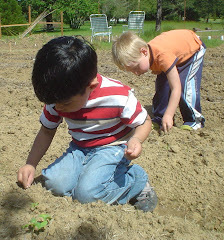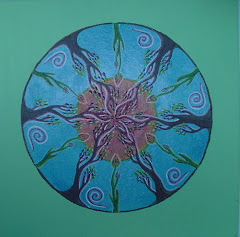Hi folks - We've just made an amazing discovery. We love quince! When prepared as the recipe outlines
below, quince tastes like a pear/lemon fruit with a hint of peach and
rose-oil! Ambrosia!
We've been reluctant to try them because they're so darn hard to cut open
which makes them seem like a real pain to prepare. Also, they are very
tart when they're raw and every recipe we'd heard of called for lots of
sugar. We're always trying to find ways to limit our sugar
intake, not add to it! So, until we discovered the joys of quince, we
just figured our compost piles were going to have a nice big influx of
worm-food in a month or two.
That is, until I (Llyn) looked up their nutritional content and Chris and I were pretty impressed - particularly as a good source of zinc and copper. Minerals are often the most difficult nutrients to get enough of in our modern diets. Most farm soils are increasingly depleted and, unless you're getting your food from an organic farmer who replenishes those minerals in natural ways that the plants can absorb, (like wood ash - LINK) it may be difficult to get enough minerals from your diet without taking any vitamin supplements (which we don't). Quince are also low-calorie, high in anti-oxidants and great for digestion (their natural pectin is soothing to the gut!). Who knew? LINK
While I was browsing for more general info about the quince, I found a recipe that suggested boiling them for 8-10 min before baking them and then my cooking creativity kicked in and I came up with the recipe below. I've made it twice so I'm still fine-tuning it (so check back for updates!) But the best thing is, this recipe calls for no refined cane sugar (just maple-syrup, and not much of that) and is easy to prepare.
The Recipe:
4-6 medium-sized quince (about 5 cups)
4-5 medium yellow pears (about 3 cups) (or sweet apples)
1/3 cup maple syrup (about 1 TBSP maple syrup per cup of quince)
1 TBSP lemon juice (don't over-do the lemon, as quince is plenty tart already!)
1 tsp cinnamon
Choose uniformly yellow, fully ripe fruit without bruises or other damage. It helps if they are a uniform size (for boiling phase).
Bring a pan of water to boil - deep enough to mostly cover the quince.
Using your bare hands, run the quince under water and rub as much of the fuzz off as you can (don't worry if you miss some).
Place in boiling water for 8-10 minutes, depending on size. I think I over-did it the second time I made this. I was trying to soften the fruit all the way through but the core remained quite hard, even with longer boiling and the second time the outer fruit got rather mushy.
Lift the quince out of the boiling water and allow to cool.
Preheat oven to 375 degrees. Grease a baking dish with coconut oil or butter.
Combine ingredients for sauce in a measuring cup with a lip for pouring.
Once cool, using a cutting board, cut off any brown spots or other blemishes on the fruit.
Slice the remaining fruit away from the core in as big pieces as possible (see picture). Your knife won't want to go through the core at all. It's super-hard! Just keep shaving off pieces all the way around the core till you've gotten as much as is easy.
Cut the fruit into bite-sized pieces.
Wash and core the pears. Cut into bite-sized pieces.
Mix the fruit together by layering it into the baking pan.
Drizzle the sauce over top of the fruit. Gently stir the fruit and sauce together to spread sauce evenly.
Use a pan with a lid, or cover with aluminum-foil.
Bake for forty-minutes covered (or until juices are boiling).
Take out, gently fold the fruit and sauce together so the fruit at the top gets re-sauced.
Leave cover off and bake for 10 more minutes to lightly caramelize the top.
We like ours chilled with a scoop of organic low-fat,
plain yogurt and some organic, lightly sweetened shredded-wheat cereal
crushed on top.
We'll keep experimenting...seems like raisins or date-pieces would be good raw or cooked in with the fruit. Also, some crushed walnuts or granola might be good too.
A Quince Essential Fruit - here's a fun post that gives more details about this unique fruit including growing tips.
Let us know of your discoveries/variations in the comments below.
 |
| Quince after harvest. Photo credit: LINK |
That is, until I (Llyn) looked up their nutritional content and Chris and I were pretty impressed - particularly as a good source of zinc and copper. Minerals are often the most difficult nutrients to get enough of in our modern diets. Most farm soils are increasingly depleted and, unless you're getting your food from an organic farmer who replenishes those minerals in natural ways that the plants can absorb, (like wood ash - LINK) it may be difficult to get enough minerals from your diet without taking any vitamin supplements (which we don't). Quince are also low-calorie, high in anti-oxidants and great for digestion (their natural pectin is soothing to the gut!). Who knew? LINK
While I was browsing for more general info about the quince, I found a recipe that suggested boiling them for 8-10 min before baking them and then my cooking creativity kicked in and I came up with the recipe below. I've made it twice so I'm still fine-tuning it (so check back for updates!) But the best thing is, this recipe calls for no refined cane sugar (just maple-syrup, and not much of that) and is easy to prepare.
 |
| Pears (on left). Whole, boiled quince (in bowl). Quartered quince (below) - this picture was taken before I figured out how to cut fruit away from core (see below). |
4-6 medium-sized quince (about 5 cups)
4-5 medium yellow pears (about 3 cups) (or sweet apples)
1/3 cup maple syrup (about 1 TBSP maple syrup per cup of quince)
1 TBSP lemon juice (don't over-do the lemon, as quince is plenty tart already!)
1 tsp cinnamon
Choose uniformly yellow, fully ripe fruit without bruises or other damage. It helps if they are a uniform size (for boiling phase).
Bring a pan of water to boil - deep enough to mostly cover the quince.
Using your bare hands, run the quince under water and rub as much of the fuzz off as you can (don't worry if you miss some).
Place in boiling water for 8-10 minutes, depending on size. I think I over-did it the second time I made this. I was trying to soften the fruit all the way through but the core remained quite hard, even with longer boiling and the second time the outer fruit got rather mushy.
Lift the quince out of the boiling water and allow to cool.
Preheat oven to 375 degrees. Grease a baking dish with coconut oil or butter.
Combine ingredients for sauce in a measuring cup with a lip for pouring.
Once cool, using a cutting board, cut off any brown spots or other blemishes on the fruit.
Slice the remaining fruit away from the core in as big pieces as possible (see picture). Your knife won't want to go through the core at all. It's super-hard! Just keep shaving off pieces all the way around the core till you've gotten as much as is easy.
 |
| Cut fruit away from the hard core. |
Wash and core the pears. Cut into bite-sized pieces.
Mix the fruit together by layering it into the baking pan.
Drizzle the sauce over top of the fruit. Gently stir the fruit and sauce together to spread sauce evenly.
 |
| Quince, pears and sauce - before baking. |
Bake for forty-minutes covered (or until juices are boiling).
Take out, gently fold the fruit and sauce together so the fruit at the top gets re-sauced.
Leave cover off and bake for 10 more minutes to lightly caramelize the top.
 |
| After baking. Yum! |
We'll keep experimenting...seems like raisins or date-pieces would be good raw or cooked in with the fruit. Also, some crushed walnuts or granola might be good too.
A Quince Essential Fruit - here's a fun post that gives more details about this unique fruit including growing tips.
Let us know of your discoveries/variations in the comments below.





































No comments:
Post a Comment